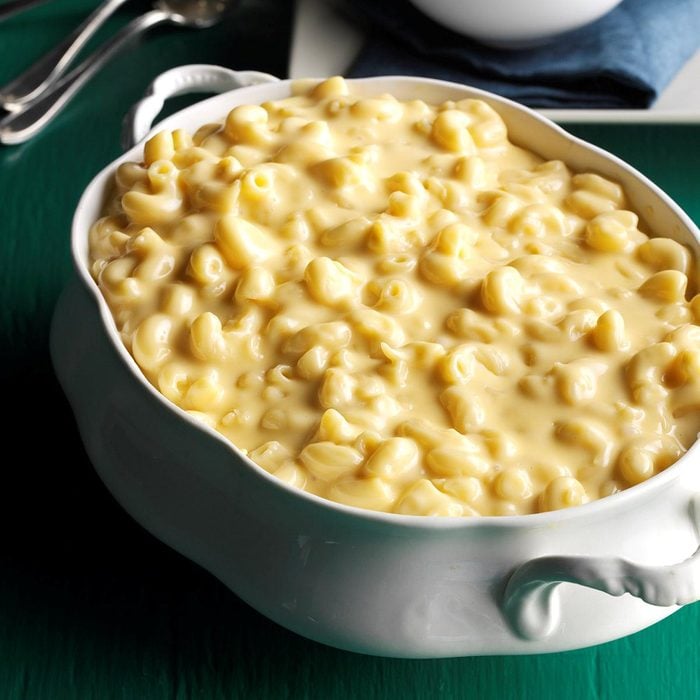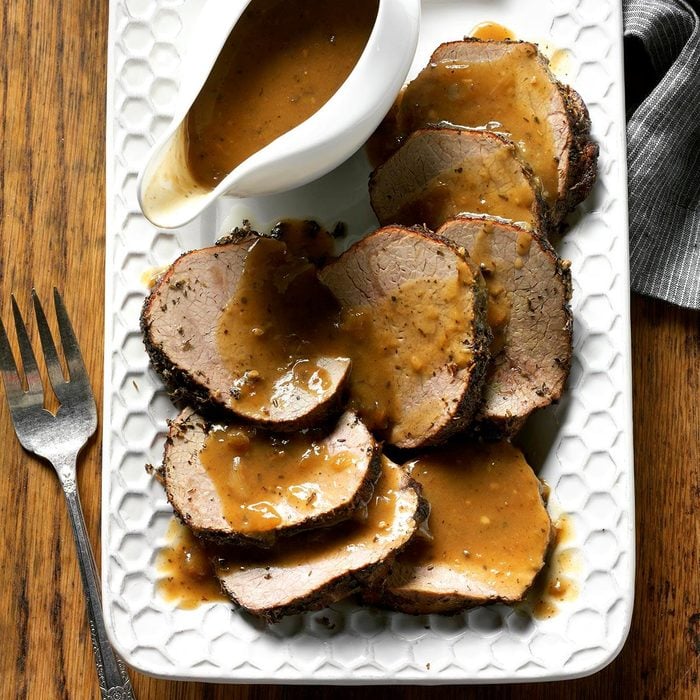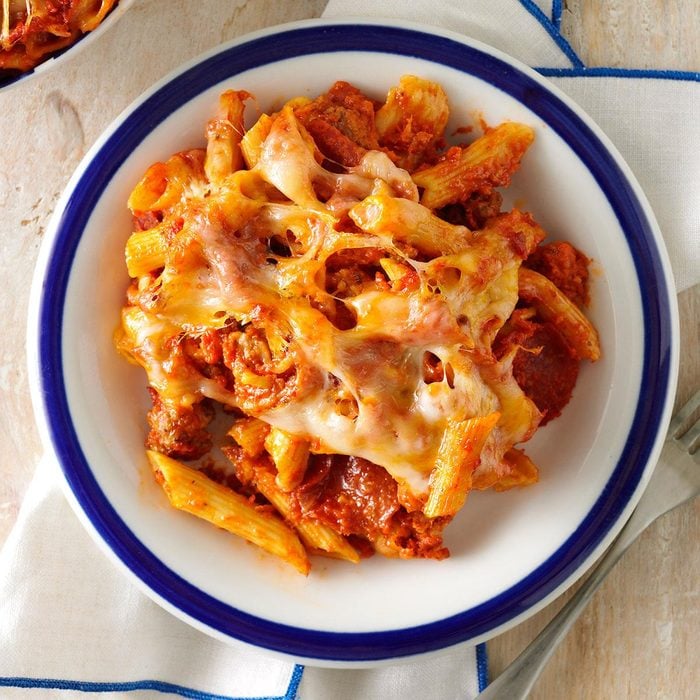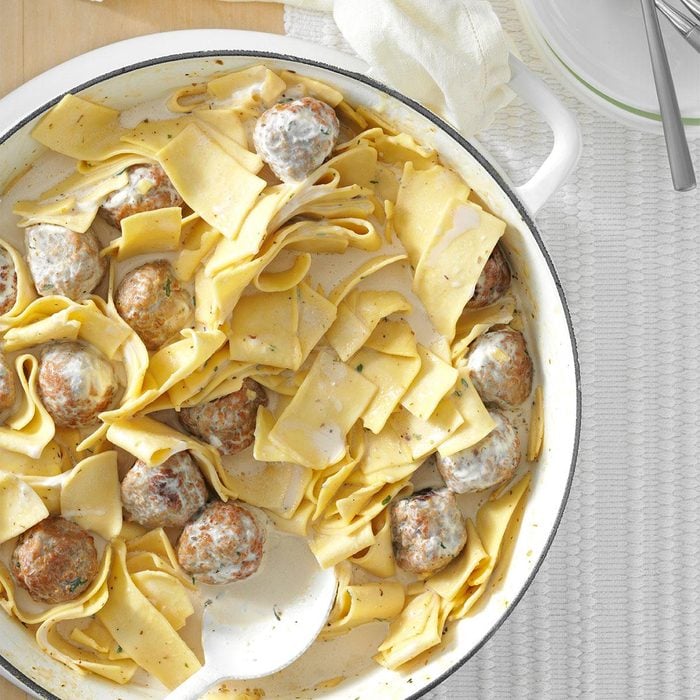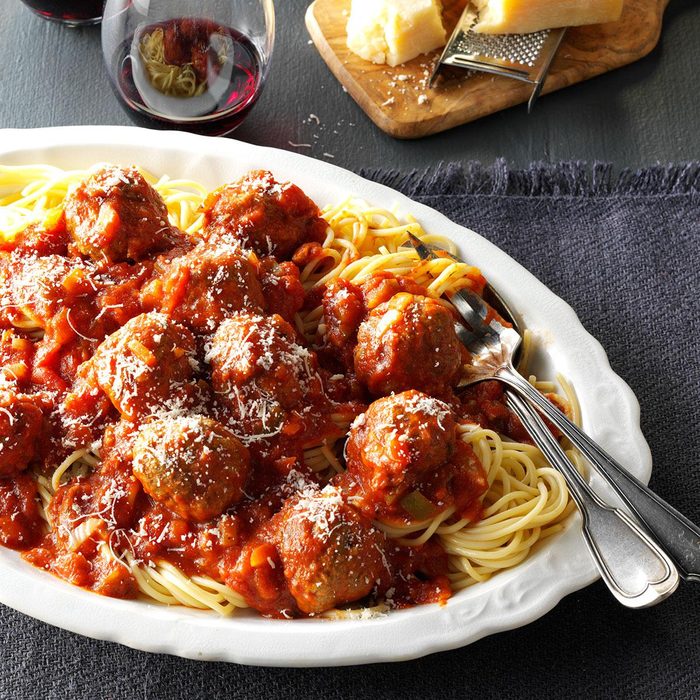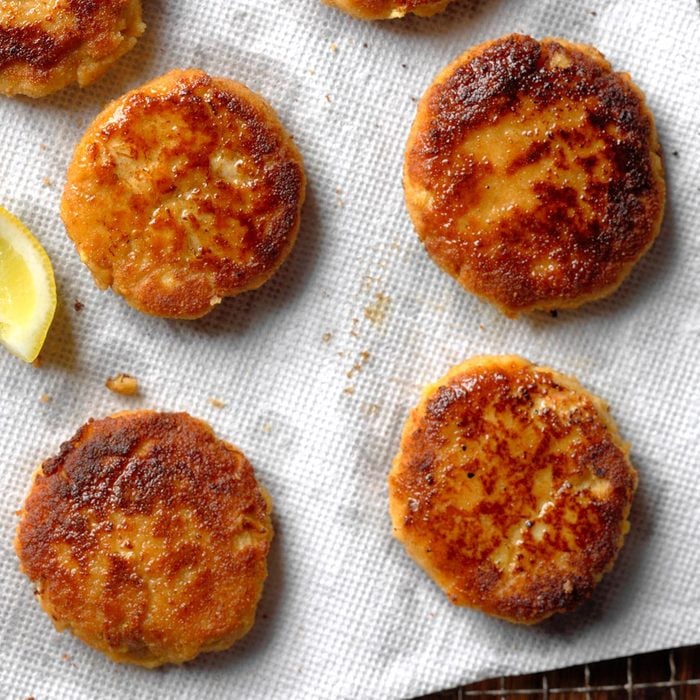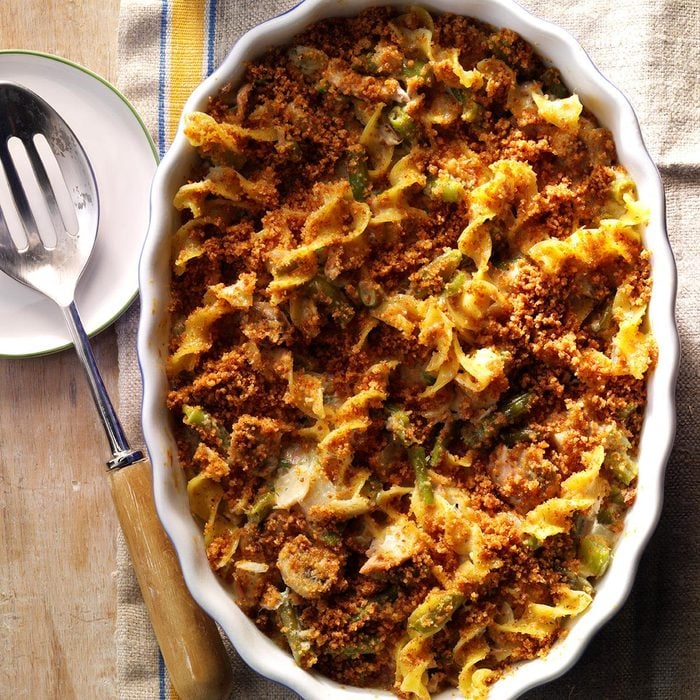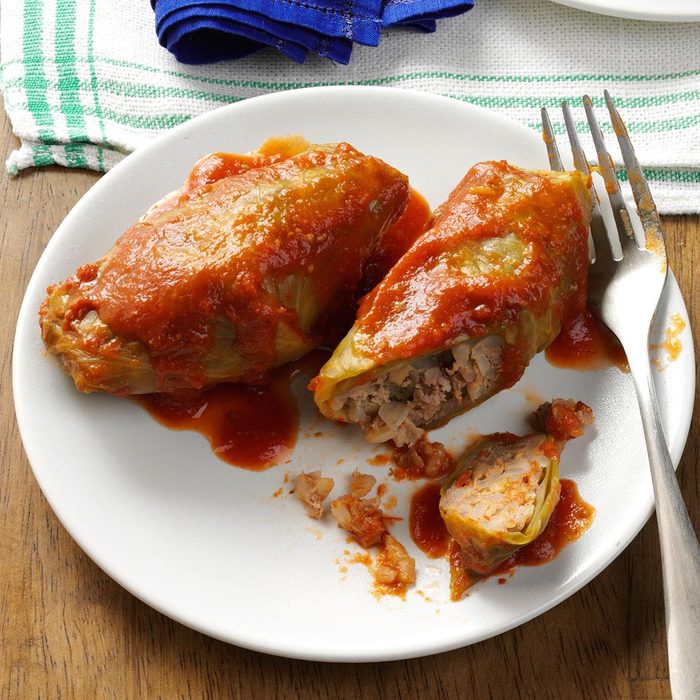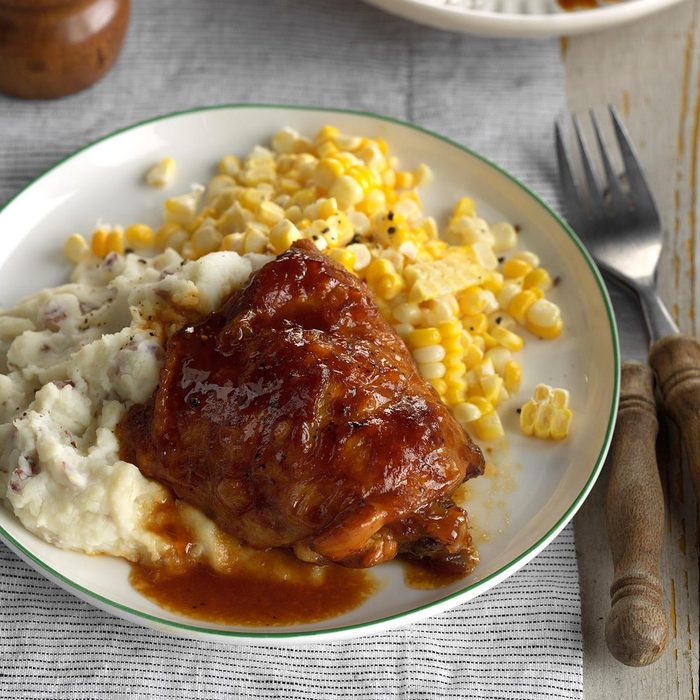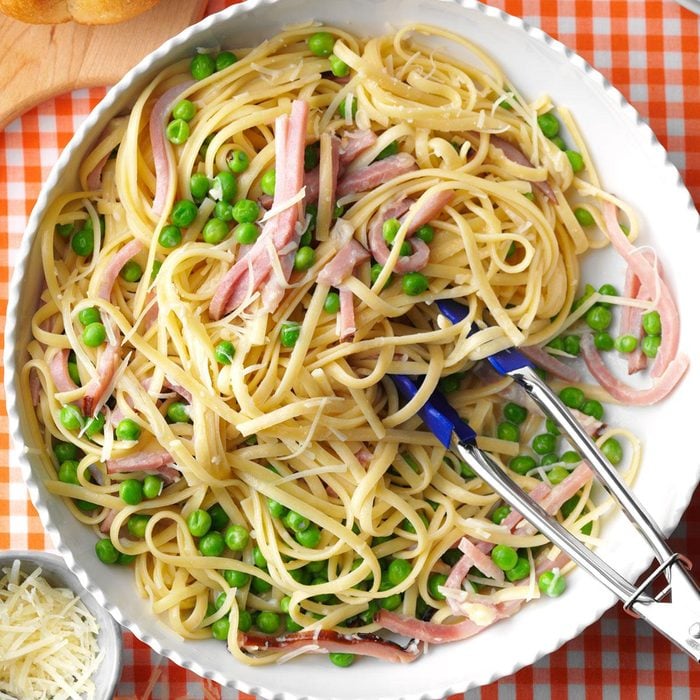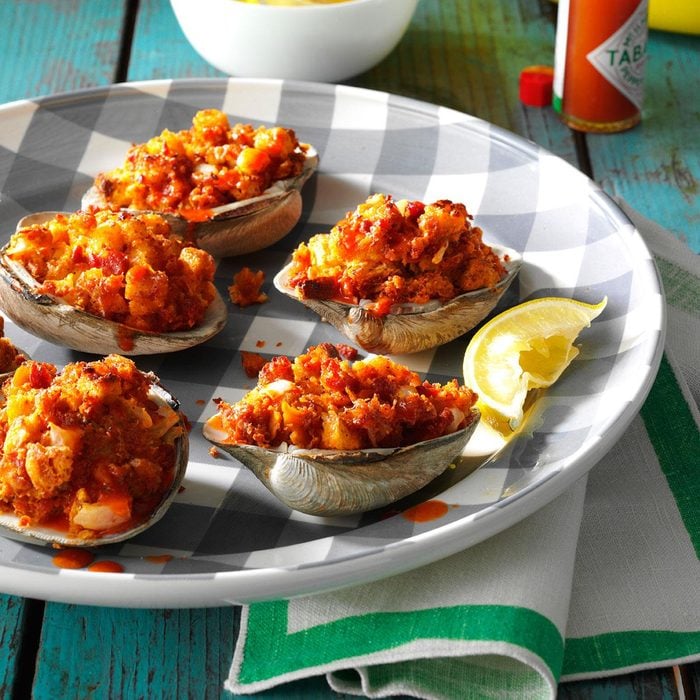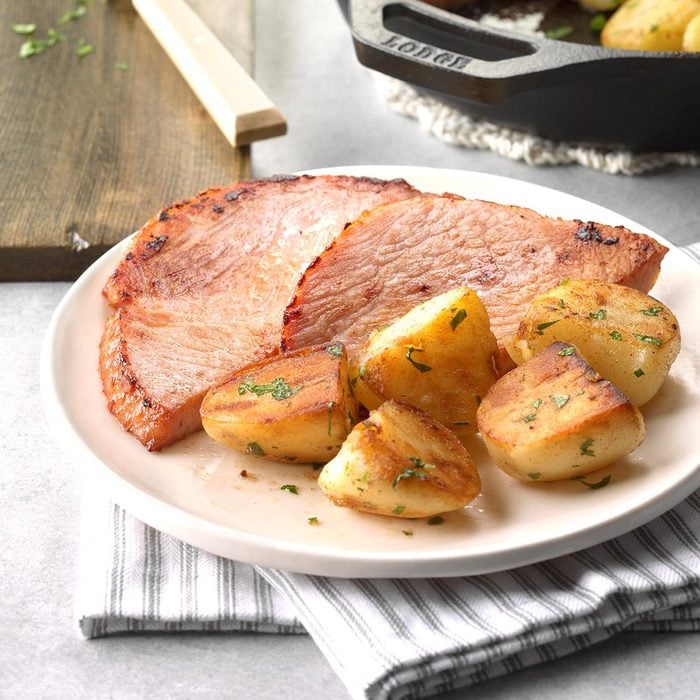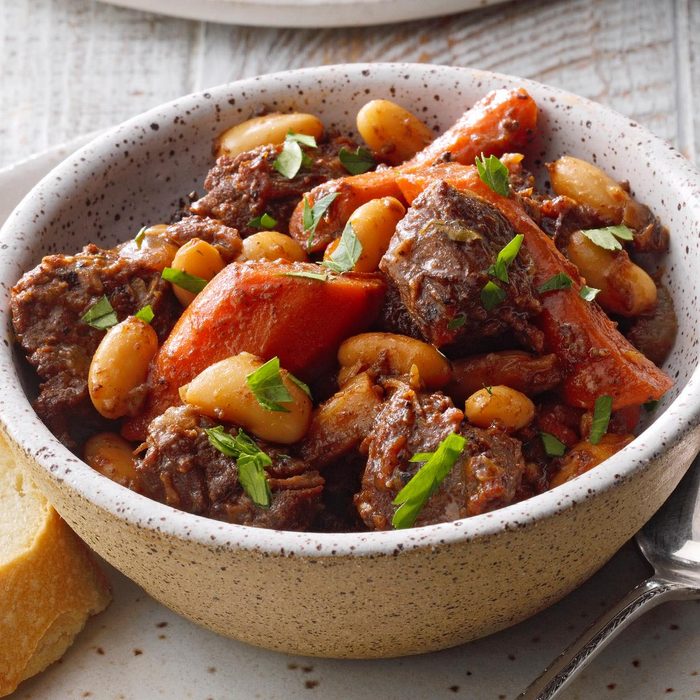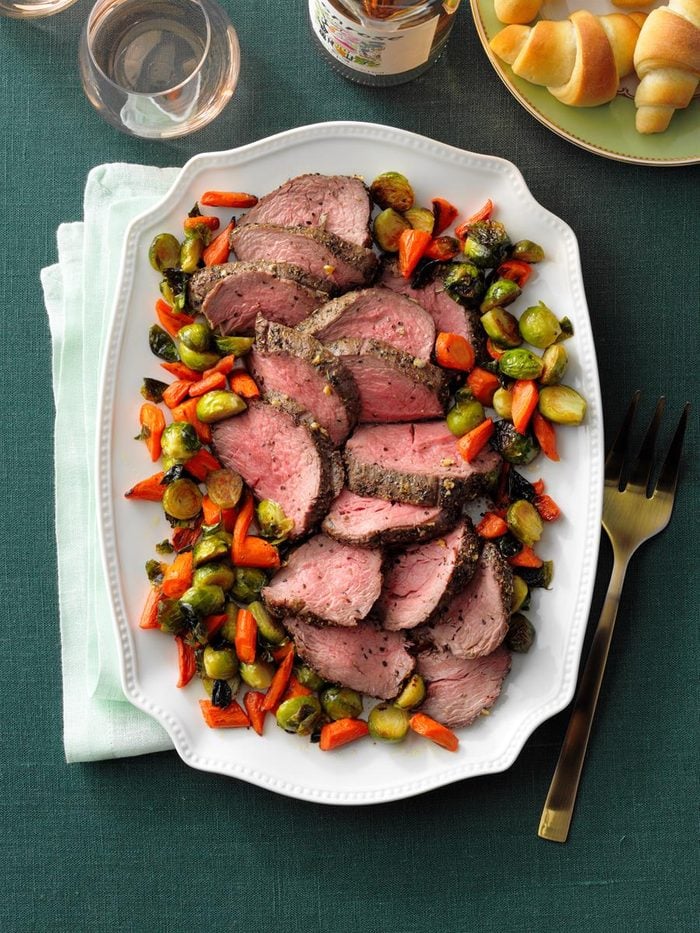Melt-in-Your-Mouth Chuck Roast
My husband and I like chuck roast recipes, so this slow-cooked recipe is terrific. You'll also love how flavorful and tender this comforting beef chuck roast turns out. —Bette McCumber, Schenectady, New York
Go to Recipe
Beef and Mushrooms with Smashed PotatoesI was inspired to make this recipe after I couldn't stop thinking of a similar dish served in my elementary school cafeteria more than 50 years ago! I like that it's quick to make, and my husband and grandchildren love it. —Ronna Farley, Rockville, Maryland. Need some more fast meals? Try out these
quick comfort food recipes.
Potluck Macaroni and CheeseYou'll always have a winner at the potluck when you bring macaroni and cheese. Here's an extra-rich, creamy version for the slow cooker. —Jennifer Blondek, Chicopee, Massachusetts
Best Chicken PotpieThis is the best chicken potpie recipe! Chock-full of chicken, potatoes, peas and corn, this recipe makes two golden pies, so you can serve one at supper and save the other for a busy night. —Karen Johnson, Bakersfield, California
Contest-Winning Broccoli Chicken CasseroleThis delicious chicken and broccoli casserole recipe is a twist on chicken divan that came from an old boss. It’s quick, satisfying comfort food. —Jennifer Schlachter, Big Rock, Illinois.
Cream of Celery Soup RecipeThis rich cream of celery soup recipe will warm up any family gathering or quiet evening at home. With just the right amount of onion flavor, it's creamy and crowd-pleasing. —Janet James, Bluff City, Tennessee
Hungarian Chicken PaprikashMy mom learned to make this Hungarian chicken paprikash when she volunteered to help prepare the dinners served at her church. It's my favorite main dish, and the gravy, seasoned with paprika, sour cream and onions, is the best. —Pamela Eaton, Monclova, Ohio
Shrimp QuesadillaQuick and simple enough for any weekday, these shrimp quesadillas boast a refreshing flavor special enough for guests. Serve with salsa on the side and a frosty smoothie, if you like. —Tiffany Bryson-San Antonio, Texas
Chicken and GravyHere's a lightened-up take on the classic southern comfort-food dish: chicken and gravy. This recipe has been a hit at our house since the first time we tried it! —Ruth Helmuth, Abbeville, South Carolina
Salmon Chowder RecipeI've lived on a farm in the Yakima Valley all my life. I have a big garden, and by the end of fall, my cellar shelves are full of canned fruits and vegetables. This salmon chowder recipe uses some of the root vegetables I grow…along with the delicious salmon that is so plentiful here. —Josephine Parton, Granger, Washington
Broccoli-Stuffed ChickenI was born in 1936 to a family of eight. Much of our food came from our garden and the henhouse. Mother served fried chicken every Sunday, but sometimes she surprised us with this broccoli-stuffed chicken. No arguments then as to who got what piece of chicken! —Donald Laugherty, Connellsville, Pennsylvania
Turkey Shepherd’s PieWe live way out in the county, and the nearest grocery store is 25 miles away. So I've become quite skilled at turning leftovers into second-time-around successes like this turkey shepherd's pie. —Linda Howe, Jackman, Maine
Ground Turkey Vegetable SoupLow-sodium ingredients don't diminish the full flavor of this brothy ground turkey vegetable soup. The turkey lends a heartiness that everyone will welcome on a cold blustery evening. —Bonnie LeBarron, Forestville, New York
Steak and Shrimp KabobsThese steak and shrimp kabobs make any get-together special. Cubes of marinated steak are skewered with shrimp and veggies, then grilled. For picnics, I assemble the kabobs at home and carry them in a large container. —Karen Mergener, St. Croix, Minnesota
Slow-Cooker Pork LoinI live in Arizona, and this slow-cooker pork loin is an easy dish with many southwestern seasonings. It's fantastic with rice and beans or in a taco with hot sauce. —Johnna Johnson, Scottsdale, Arizona
Swedish Meatball RecipeMom fixed this Swedish meatball recipe for all sorts of family dinners, potluck suppers and PTA meetings. The scent of browning meat is intoxicating. Add to that the sweet smell of onions caramelizing, and everyone’s mouth starts watering. —Marybeth Mank, Mesquite, Texas
Crockpot SpareribsEven my three little ones love these easy-to-make and delicious-to-eat slow-cooker spareribs. The succulent meat falls right off the bone! —Julie Czmer, West Bloomfield, Michigan
Chicken Parmesan SpaghettiI like to make this yummy chicken Parmesan with spaghetti when I have extra sauce on hand. The herbed coating on the tender chicken gets nice and golden. —Margie Eddy, Ann Arbor, Michigan
Healthy Turkey ChiliI've taken my mother's healthy turkey chili recipe and made it thicker and more robust. It's a favorite, especially in fall and winter. —Celesta Zanger, Bloomfield Hills, Michigan
Instant Pot Whole ChickenWe love rotisserie chicken, and now with a pressure cooker, I can have it ready to eat in an hour or so. I combined several recipes to come up with this favorite. If you are new to the kitchen tool, this is a perfect recipe to begin with since it is so easy. —Joan Hallford, North Richland Hills, Texas
Hamburger StroganoffThis easy hamburger stroganoff makes a quick weeknight dinner. I like to serve it with a side salad for a complete meal. —Deb Helmer, Lynden, Washington
Zucchini BoatsAfter working hard all our lives and raising a family, we're now enjoying a simpler life. Getting back to the basics means enjoying old-fashioned comfort foods like these stuffed zucchini boats. —Mrs. C. Thon, Atlin, British Columbia
Creamed Garden Potatoes and PeasNew potatoes and peas are treated to a creamy sauce for this special side. —Jane Uphoff, Cunningham, Kansas
De-Lightful Tuna CasseroleThis mild, homemade tuna casserole will truly satisfy your family's craving for comfort food without all the fat! —Colleen Willey, Hamburg, New York
Saucy Pork Chop SkilletSkillet pork chops make easy comfort food. We have them with a salad and fruit. If you've got fresh green beans or steamed broccoli, go for it. —Donna Roberts, Manhattan, Kansas
Air-Fryer BratsThese air-fryer brats are a nod to my German heritage. I serve them with a green vegetable and some french fries or mashed potatoes on the side. For a deeper sauce flavor, try using a lager or stout beer. —Allison Ochoa, Hays, Kansas
Ultimate Pot RoastDutch oven pot roast recipes are the ultimate comfort food. When juicy pot roast simmers in garlic, onions and veggies, everyone comes running to ask "When can we eat?" The answer? Just wait—it will be worth it. —Taste of Home Test Kitchen
Turkey Salisbury SteaksMy mother always made Salisbury steak. When I married, I developed my own, and it just may be the recipe my husband asks for the most. —Leann Doyle, Patchogue, New York
Cube Steak and GravyCube steaks and gravy are a hearty home-style dinner your family will love after a busy day. The slow-cooked beef is wonderful served over mashed potatoes or noodles. —Judy Long, Limestone, Tennessee
Tender Salsa BeefThis is my Mexican-style twist on comfort food. To keep it kid-friendly, use mild salsa. —Stacie Stamper, North Wilkesboro, North Carolina
Light Chicken and Broccoli BakeCheesy chicken and broccoli bakes are the ultimate comfort food, but I wanted to give the classic casserole a healthier spin. Mine cuts down on fat and calories, but keeps the same cozy flavor. —Jenny Dubinsky, Inwood, West Virginia
Sunday Roast ChickenThis recipe proves that comfort food doesn't have to be full of unwanted calories. Mixed with orange and lemon juice, my roast chicken is both flavorful and healthy. —Robin Haas, Cranston, Rhode Island.
Arborio Rice and White Bean SoupSoup is the ultimate comfort food. This hearty, satisfying soup with arborio rice is low in fat and comes together in less than 30 minutes. —Deanna McDonald, Grand Rapids, Michigan
Au Gratin Peas and PotatoesWhile this delicious potato skillet is a wonderful side dish, we find it satisfying enough to be a main course, too. The skillet preparation takes less time than it does to bake an au gratin casserole or scalloped potatoes—but it's still good old-fashioned comfort food at its best! —Marie Peterson, DeForest, Wisconsin
Rigatoni with Sausage & PeasWith a tomato-y meat sauce and tangy goat cheese, this weeknight wonder is my version of comfort food. You want to have bowl after bowl. —Lizzie Munro, Brooklyn, New York
Cheesy Ham ChowderMy five children all agree that this soothing recipe is wonderful. The soup is full of potatoes, carrots and ham. The best part is that I can get it on the table in only a half hour of hands-on time. —Jennifer Trenhaile, Emerson, Nebraska
Mom's Roast BeefEveryone loves slices of this fork-tender roast beef with its savory gravy. The well-seasoned roast is Mom's specialty. People always ask about the secret ingredients. Now you have the delicious recipe for our favorite meat dish! —Linda Gaido, New Brighton, Pennsylvania
Best-Ever Fried ChickenCrispy, juicy and perfectly seasoned, this really is the best fried chicken recipe, ever. Summer reunions and neighborly gatherings will never be the same. When I was growing up, my parents had a farm, and every year, Dad would hire teenage boys to help by haying time. They looked forward to coming because they knew they would be treated to some of Mom's deep fryer recipes, including this delicious fried chicken. —Lola Clifton, Vinton, Virginia
Firecracker ShrimpThese delightful firecracker shrimp are coated in a sweet and spicy glaze. The marinade comes together in moments for sizzling shrimp skewers. —Mary Tallman, Arbor Vitae, Wisconsin
Meat Lover's Pizza Hot DishI make this hearty casserole for the men who help us out during harvesttime. Every year they say it’s the best—hands down. Throw in any pizza toppings your family likes—Canadian bacon, black olives and green peppers are some of our picks. —Brook Bothun, Canby, Minnesota
Root Vegetable Pot RoastDuring the hectic holiday season, I make this roast a lot. We've scarfed it down before and after shopping, and while wrapping presents. Root vegetables and roast beef make everyone feel cozy and calm. —Pat Dazis, Charlotte, North Carolina
Easy Meatball StroganoffThis recipe has fed not only my own family, but also many neighborhood kids. They come running when I make this supper. It's one of those things you throw together after work on a busy day because you know it works. —Julie May, Hattiesburg, Mississippi
Chili Dog CasseroleKids and dads alike will dive right into this hearty, comforting dish. With a crispy cheese topping on a warm corn bread crust, this chili dog casserole recipe is a keeper. —Taste of Home Test Kitchen
Sunday Pot RoastWith the help of a slow cooker, you can prepare a down-home dinner any day of the week, not just on Sundays. The roast turns out tender and savory every time. —Brandy Schaefer, Glen Carbon, Illinois
Slow-Cooker Spaghetti & MeatballsI’ve been cooking for 50 years, and this dish is still one that guests request frequently. It is my No. 1 standby recipe and also makes amazing meatball sandwiches. The sauce works for any type of pasta. —Jane Whittaker, Pensacola, Florida
Seasoned Crab CakesAt the National Hard Crab Derby in Crisfield, Maryland, these scrumptious crab cakes won me first place. I entered them on a whim after trying many crab cake recipes for my family. —Betsy Hedeman, Timonium, Maryland
Potato SoupI decided to add some character to a basic potato chowder with a jar of roasted red peppers. The extra flavor gives a deliciously different twist to an otherwise ordinary soup. —Mary Shivers, Ada, Oklahoma
Pork Chops with Creamy Mustard NoodlesA fast, creamy skillet sauce dresses up everyday pork chops and noodles. Chicken also works well with this recipe and the zesty mix of mustards.—Margaret Bracher, Robertsdale, Alabama
Creole JambalayaJambalaya is a traditional Louisiana dish, coming from our Spanish and French culture. Rice is the main ingredient, with different meats or seafood mixed in. I particularly like this variation with shrimp and ham. —Ruby Williams, Bogalusa, Louisiana
Chicken and Swiss Stuffing BakeI love to cook but just don't have much time. This casserole is both comforting and fast, which makes it my favorite kind of recipe. I serve it with a green salad. —Jena Coffey, Sunset Hills, Missouri
Blue Cheese-Crusted Sirloin SteaksMy wife adores this steak—and me when I fix it for her. She thinks it’s the ideal dish for Friday night after a long workweek. —Michael Rouse, Minot, North Dakota
Roasted ChickenThis tender chicken is a real time-saver on a busy weekend. A simple blend of seasonings makes it a snap to prepare, and it smells heavenly as it roasts. —Marian Platt, Sequim, Washington
Cassoulet for TodayFrench cassoulet is traditionally cooked for hours. This version of the rustic dish offers the same homey taste in less time. It’s easy on the wallet too. —Virginia Anthony, Jacksonville, Florida
Beef Paprikash with Fire-Roasted TomatoesBeef paprikash, a Hungarian dish, makes a marvelous Sunday dinner. We prefer it with kluski egg noodles, or try mashed potatoes. —Gloria Bradley, Naperville, Illinois
Chicken Rice SkilletPleasant seasonings and plenty of vegetables highlight this traditional chicken and rice pairing. Leftovers are great reheated in the microwave. —Jan Balata, Kilkenny, Minnesota
Sunday Chops and StuffingMy family likes to make these chops for Sunday dinner. The recipe lets us spend more time having fun together and less time cooking. —Georgiann Franklin, Canfield, Ohio
Quicker Chicken and DumplingsReady in just 30 minutes, this homey meal relies on convenience items and timesaving drop-style dumplings. It couldn’t be any easier! —Willie DeWaard, Coralville, Iowa
Bean & Beef Slow-Cooked ChiliThis chili may be already chock-full, but we love to build it up even more with toppings like pico de gallo, red onion, cilantro and cheese. —Mallory Lynch, Madison, Wisconsin
Homemade Fish SticksI am a nutritionist and needed a healthy fish fix. Moist inside and crunchy outside, these are amazing with oven fries or roasted veggies and low-fat homemade tartar sauce. —Jennifer Rowland, Elizabethtown, Kentucky
Slow-Cooker Beef TipsAs a busy mom, I love my slow-cooker meals! Beef tips remind me of a childhood favorite. I make this slow-cooker beef tips recipe with mushrooms and red wine, then serve over brown rice, noodles or mashed potatoes. —Amy Lents, Grand Forks, North Dakota
Tuna Mushroom CasseroleI love to serve this dressed-up version of a tuna casserole. The green beans add nice texture, color and flavor. The first time I made this dish, my uncle asked for seconds even though tuna casseroles are not usually his favorite.
—Jone Furlong, Santa Rosa, California
Beef & Rice Stuffed Cabbage RollsThis recipe is special to me because it’s an easy one-pot meal that tastes like you spent the whole day in the kitchen. My family loves it. —Lynn Bowen, Geraldine, Alabama
Saucy Chicken ThighsEveryone raves about how sweet the sauce is for these slow-cooked chicken thighs. They’re such a breeze because they simmer away while you do other things. They’re ideal appetizers, but you can also add your favorite side for a nice meal. —Kim Puckett, Reagan, Tennessee
Mom's Meat LoafMom made the best meat loaf, and now I do too. When I first met my husband, he wasn't a meat loaf guy, but this recipe won him over. —Michelle Beran, Claflin, Kansas
Hay and StrawThis recipe is not only quick and easy to prepare, it's pretty, too. This colorful pasta dish combines julienned ham, Parmesan cheese, peas and linguine.—Priscilla Weaver, Hagerstown, Maryland
Deviled ChickenMy family has always loved this flavorful golden brown chicken. I watch for frequent sales on leg quarters to keep the cost per serving low. —Linda Trammell, Kingston, Missouri
Beef in Onion GravyI double this super recipe to feed our family of four so I'm sure to have leftovers to send with my husband to work for lunch. His co-workers tell him he's lucky to have someone who fixes him such special meals. It's our secret that it's an easy slow cooker dinner! —Denise Albers, Freeburg, Illinois
Easy Chicken Cordon Bleu"Cordon Bleu" is a French phrase meaning "blue ribbon"—given as a prize for culinary excellence. The term also refers to a signature dish of chicken topped with a slice of ham and Swiss cheese, usually breaded and sauteed, or in this case, wrapped in puff pastry for a quick and easy finish. —Sharon Laabs, Hartford, Wisconsin
Hungarian Short RibsThis is a special meal in our house—as soon as I get ribs, I know which dish my family will ask me to make. My husband and I have three children, so I've learned to be a versatile cook! —Joanne ShewChuk, St. Benedict, Saskatchewan
Dad's Famous StuffiesThe third of July is almost as important as July Fourth in my family. We make these stuffed clams on the third every year, and it's an event in and of itself! —Karen Barros, Bristol, Rhode Island
Country Ham and PotatoesBrowned potatoes are a simple but perfect side for country ham. Not only do the potatoes pick up the flavor of the ham, but they look beautiful! Just add veggies or a salad and dinner’s done. —Helen Bridges, Washington, Virginia
Chicken and Wild Rice BakeMy chicken and rice bake is a lovely example of midwestern cuisine. The dish is ideal for hosting parties because it can bake while you turn your attention to other preparations. —Suzanne Greenslit, Merrifield, Minnesota
Meatballs and GravyI can still see Grandmother making dozens of these little meatballs, and gravy to go with them! The hint of spices gives them a savory taste that makes them authentically Norwegian. —Karen Hoylo, Duluth, Minnesota
Clam StewThis clam stew highlights the fresh, sweet and salty clam flavor, with the chorizo adding a little kick. Fresh Swiss chard greens from our garden, corn and cannellini beans round out the flavor profile. The best part, though, is dipping crusty bread into the delicious broth! —Pamela Gelsomini, Wrentham, Massachusetts
Big John's Chili-Rubbed RibsWhen my family thinks of summer grilling, it's ribs all the way. Our Asian-inspired recipe is a welcome change from the usual barbecue-sauce versions. —Ginger Sullivan, Cutler Bay, Florida
Boeuf BourguignonMy mother-in-law shared this recipe with me about 25 years ago. Ever since then, it's been a go-to whenever I need good food without a lot of fussing. —Mary Lou Timpson, Colorado City, Arizona
Creamy Paprika PorkWhen I was little, I would often ask my mom to make "favorite meat." She knew I was requesting this homey pork recipe. It's been in my family for more than 30 years and it's still a favorite! —Alexandra Barnett, Forest, Virginia
Slow-Cooker Pot RoastBecause I work full time, this slow cooker pot roast is my go-to when I want a hearty, home cooked meal. It’s a comfort to walk in and smell this roast simmering. —Gina Jackson, Ogdensburg, New York
Best LasagnaWant to know how to make lasagna for a casual holiday meal? You can't go wrong with this deliciously rich meat lasagna recipe. My grown sons and daughter-in-law request it for their birthdays, too. —Pam Thompson, Girard, Illinois
The Ultimate Chicken Noodle SoupMy first Wisconsin winter was so cold, all I wanted to eat was homemade chicken noodle soup. Of all the chicken noodle soup recipes out there, this
type of soup is my favorite and is in heavy rotation from November to April. It has many incredibly devoted fans.—Gina Nistico, Denver, Colorado
Meat Loaf with OatmealA simple blend of seasonings results in a hot and hearty meat loaf that's big on flavor and very satisfying. —Lauree Buus, Rapid City, South Dakota
Wintertime Braised Beef StewThis easy beef stew is incredibly rich. Since it's even better a day or two later, you may want to make a double batch. —Michaela Rosenthal, Woodland Hills, California
Chicken-Fried SteakAs a child, I learned from my grandmother how to make these chicken-fried steaks. I taught my daughters, and when my granddaughters are older, I’ll show them, too. —Donna Cater, Fort Ann, New York
Sugar-Glazed HamThis old-fashioned ham glaze gives a pretty golden brown coating—just like Grandma used to make. The mustard and vinegar complement the brown sugar which adds a tangy flavor to this glazed ham recipe. Be prepared to serve seconds! —Carol Strong Battle, Heathville, Virginia
Turkey Dumpling StewMy mom made this stew when I was young, and it was always a hit. Since it's not time-consuming to make I can fix it on a weekend for our children, who love the tender dumplings. —Becky Mohr, Appleton, Wisconsin
Standing Rib RoastThis standing rib roast recipe is practically foolproof. Treat your family to tender slices of standing rib roast or use the seasoning blend on a different beef roast for a hearty, delicious main dish. I love to prepare this recipe for special occasions. —Lucy Meyring, Walden, Colorado
Porcini Mac & CheeseThis recipe was inspired by a mushroom mac and cheese I had at a local restaurant. I incorporated the fall flavor of a pumpkin ale, and it turned out better than the original. —Laura Davis, Chincoteague, Virginia
Country Ribs DinnerRibs slow-cooked with carrots, celery, onions and red potatoes are pure comfort food for us. To add a little zip, we sometimes sprinkle in cayenne. —Rose Ingall, Manistee, Michigan
Garlic Herbed Beef TenderloinYou don't need much seasoning to add flavor to this tender beef roast. The mild blend of rosemary, basil and garlic does the trick. —Ruth Andrewson, Leavenworth, Washington
Chicken Potpie CasseroleI always have leftover chicken broth on hand and use it for many things, including this comforting family favorite. You can bake your own biscuits as I do or buy them at the store. I like to bake extra biscuits to eat with butter and jam. —Liliane Jahnke, Cypress, Texas
Frito PieFrito pie is legendary in the Southwest for being spicy, salty and cheesy fabulous. Here’s my easy take on this crunchy classic. —Jan Moon, Alamogordo, New Mexico
Italian Pasta BakeI love to make this pasta bake whenever I need to bring a dish to pass. Fresh tomatoes add a nice touch that's missing from most other meat, pasta and tomato casseroles.—Karla Johnson, East Helena, Montana
Slow-Roasted Chicken with VegetablesEven a beginner cook could make this slow cooked chicken and have it turn out perfectly. This recipe could not be easier. A few minutes of prep and you'll come home to a delicious dinner. —Anita Bell, Hermitage, Tennessee
Crockpot Beef StroganoffI love to make this for my husband and myself to have on a cold night. It warms us right up! Greek yogurt can be substituted for the sour cream. —Meg Hilton, Atlanta, Georgia

































